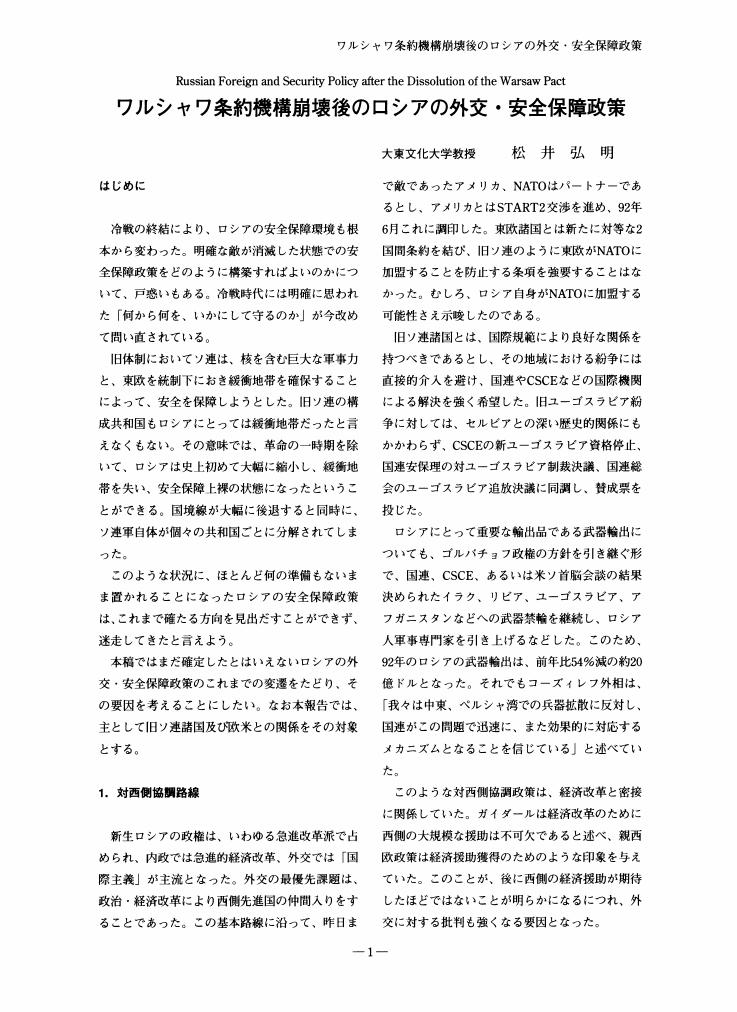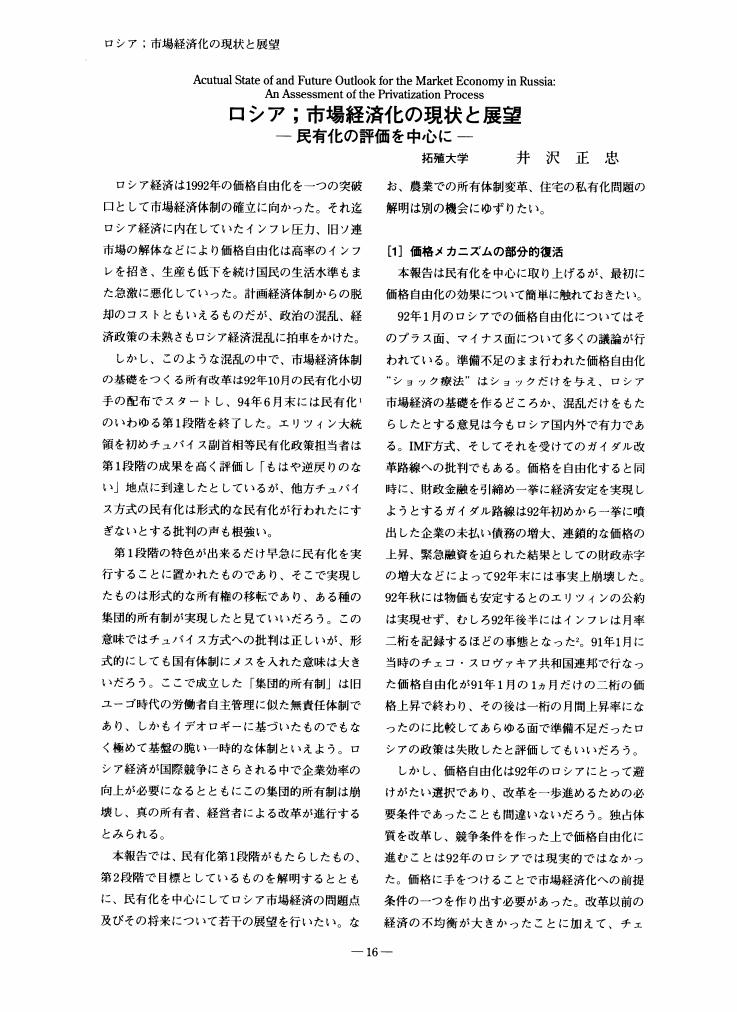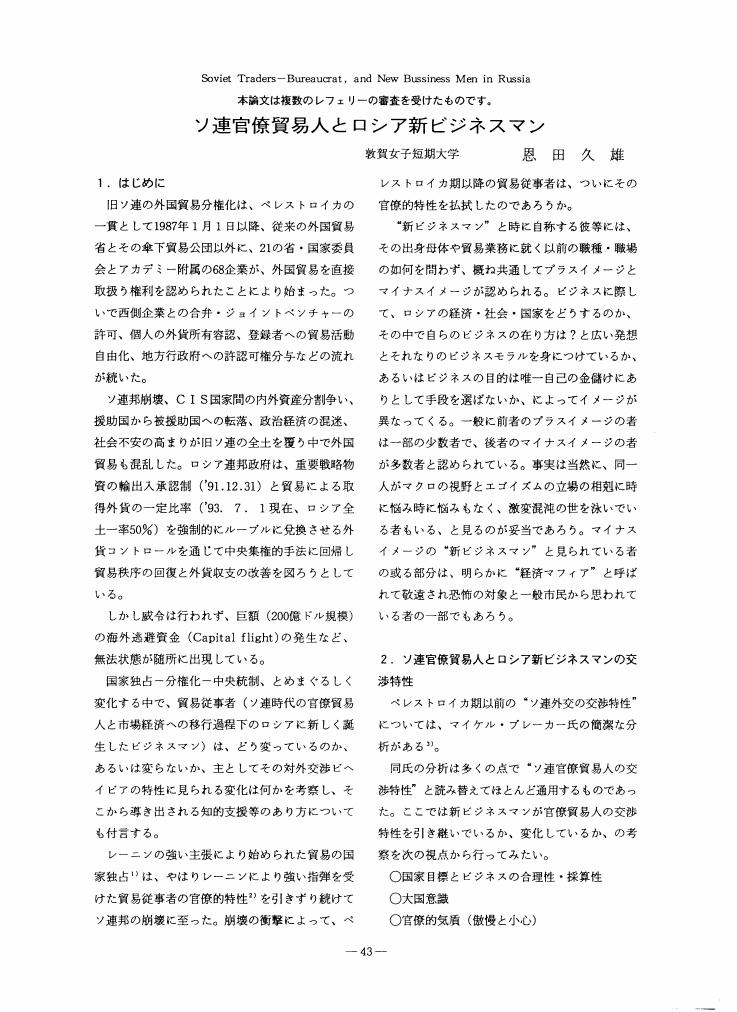1 0 0 0 OA チェコの私有化
- 著者
- 小森 吾一
- 出版者
- ロシア・東欧学会
- 雑誌
- ロシア・東欧学会年報 (ISSN:21854645)
- 巻号頁・発行日
- vol.1993, no.22, pp.84-88, 1993 (Released:2010-05-31)
- 参考文献数
- 19
- 被引用文献数
- 1
1 0 0 0 OA 書評 近藤邦康・和田春樹編「ペレストロイカと改革・開放―中ソ比較分析」
- 著者
- 中西 治
- 出版者
- ロシア・東欧学会
- 雑誌
- ロシア・東欧学会年報 (ISSN:21854645)
- 巻号頁・発行日
- vol.1993, no.22, pp.106-108, 1993 (Released:2010-05-31)
1 0 0 0 OA ワルシャワ条約機構崩壊後のロシアの外交・安全保障政策
- 著者
- 松井 弘明
- 出版者
- ロシア・東欧学会
- 雑誌
- ロシア・東欧学会年報 (ISSN:21854645)
- 巻号頁・発行日
- vol.1994, no.23, pp.1-5, 1994 (Released:2010-05-31)
1 0 0 0 OA ポスト共産主義の政治思想の動向
- 著者
- 中村 裕
- 出版者
- ロシア・東欧学会
- 雑誌
- ロシア・東欧学会年報 (ISSN:21854645)
- 巻号頁・発行日
- vol.1994, no.23, pp.6-15, 1994 (Released:2010-05-31)
- 参考文献数
- 29
1 0 0 0 OA ロシア; 市場経済化の現状と展望 ―民有化の評価を中心に―
- 著者
- 井沢 正忠
- 出版者
- ロシア・東欧学会
- 雑誌
- ロシア・東欧学会年報 (ISSN:21854645)
- 巻号頁・発行日
- vol.1994, no.23, pp.16-26, 1994 (Released:2010-05-31)
- 参考文献数
- 38
1 0 0 0 OA エリツィン政権下のロシア・マスコミ
- 著者
- 鈴木 康雄
- 出版者
- ロシア・東欧学会
- 雑誌
- ロシア・東欧学会年報 (ISSN:21854645)
- 巻号頁・発行日
- vol.1994, no.23, pp.27-32, 1994 (Released:2010-05-31)
- 参考文献数
- 9
1 0 0 0 OA ロシアにおける市場経済化と経営者形成の現段階
- 著者
- 溝端 佐登史
- 出版者
- ロシア・東欧学会
- 雑誌
- ロシア・東欧学会年報 (ISSN:21854645)
- 巻号頁・発行日
- vol.1993, no.22, pp.1-14, 1993 (Released:2010-05-31)
- 参考文献数
- 22
1 0 0 0 OA ロシアの憲法問題
- 著者
- 松下 輝雄
- 出版者
- ロシア・東欧学会
- 雑誌
- ロシア・東欧学会年報 (ISSN:21854645)
- 巻号頁・発行日
- vol.1993, no.22, pp.15-26, 1993 (Released:2010-05-31)
1 0 0 0 OA 「混沌の中の宗教界」
- 著者
- 川端 香男里
- 出版者
- ロシア・東欧学会
- 雑誌
- ロシア・東欧学会年報 (ISSN:21854645)
- 巻号頁・発行日
- vol.1993, no.22, pp.39-41, 1993 (Released:2010-05-31)
1 0 0 0 OA ソ連官僚貿易人とロシア新ビジネスマン
- 著者
- 恩田 久雄
- 出版者
- ロシア・東欧学会
- 雑誌
- ロシア・東欧学会年報 (ISSN:21854645)
- 巻号頁・発行日
- vol.1993, no.22, pp.43-50, 1993 (Released:2010-05-31)
1 0 0 0 OA 「移行期 (ソ連からロシアへ) における新たな品質改善策」 ―工作機械工業を中心にして―
- 著者
- 五十嵐 則夫
- 出版者
- ロシア・東欧学会
- 雑誌
- ロシア・東欧学会年報 (ISSN:21854645)
- 巻号頁・発行日
- vol.1993, no.22, pp.51-59, 1993 (Released:2010-05-31)
1 0 0 0 福沢諭吉とロシア
- 著者
- 外川 継男
- 出版者
- ロシア・東欧学会
- 雑誌
- Japanese Slavic and East European Studies (ISSN:03891186)
- 巻号頁・発行日
- vol.18, pp.1-10, 1997
- 著者
- 吉田 裕季
- 出版者
- ロシア・東欧学会
- 雑誌
- ロシア・東欧研究 (ISSN:13486497)
- 巻号頁・発行日
- vol.2005, no.34, pp.157-167, 2005
The Military convention of Belgrade was concluded between the Allies and Hungary when the First World War came to an end. This convention established the boundary line on the southeast part of Hungary. But this boundary line was violated by the Rumanian Army which crossed it from Transylvania on 15<SUP>th</SUP> December, 1918. Later, this line was modified in favor of Rumania.<BR>About that time the Ukrainian invasion started under the initiative of the French Army. The French Army was obviously defeated owing to a shortage of forces.<BR>Some historians argued that the Ukrainian invasion had an influence on the amendment of the boundary line. They explained that the French policies took a measure in favor of Rumania, because they wished the supplement of the shortages of forces by the Rumanian Army, accepting the territorial demands of Rumania as compensation.<BR>The purpose of this article is to explain in view of the Ukrainian invasion why the amendment of the line was realized in favor of Rumania.<BR>The first chapter makes clear the significances of the Military convention of Belgrade for Hungary, France and Rumania. This convention should accept the Hungarian territorial demands and contribute to extend the French influence on Central Europe through the occupation of Hungary. But for Rumania it would hinder her territorial claims.<BR>The second chapter makes evident through the process of the Ukrainian invasion the factors related with the amendment of the boundary line. It is quite obvious that the French Army was not enough to invade Ukraine, therefore the military authorities suggested to make a profit from the Rumanian Army. The French Army without the indigenous inhabitant's cooperation was overpowered by the Bolshevik Army. For this reason an anti-Bolshevik policy was increasingly regarded as necessary. Besides the Rumanian government had indicated her intentions to render some military services in Russia.<BR>The third chapter concerns influence of the Ukrainian invasion on the amendment of the boundary line through the discussions on the revision in the Peace Conference. There was an atmosphere in the chamber that one should defend the benefits of the Allies. Therefore on the one hand, the demands of Rumania were approved, on the other, the claims of a hostile country, Hungary, were rejected. However it remarked that France proposed to recognize Rumania as an Ally, and submitted the draft for the amendment of the line. Besides the fact that Rumania let her army march across the boundary line to make fait accompli might have served to accord her territorial demands. The French Army, however, did not occupy Hungary, for it considered that this circumstance would permit the Rumanian Army to advance.<BR>Therefore, the French policies must be emphasized as a factor of the amendment of the boundary line in favor of Rumania. In this case, however, a great importance should be attached to not only the shortages of forces, but also to the anti-Bolshevik policy and it should be also taken into consideration that an anti-Bolshevik attitude of Rumania proved to be favorable for France. With reference to the amendment of the boundary line, this policy has not been argued enough until today.
- 著者
- 松里 公孝
- 出版者
- ロシア・東欧学会
- 雑誌
- ロシア・東欧学会年報 (ISSN:21854645)
- 巻号頁・発行日
- vol.2000, no.29, pp.49-71, 2000
- 被引用文献数
- 1
Kuchma's “cassette tape scandal” in 2000-2001 exemplified the patrimonial phenomena that has become prevalent in post-communist Ukrainian politics. However, this patrimonial tendency has not been combined with classic authoritarianism but machine politics (or ‘caciquismo’), in which election votes play a decisive role in intra-elite struggles for power. As a rule, caciquismo is based on independent meso-elites which function as mobilizers of votes and also as political brokers between localities and the center. Ukraine is not an exception, although in this country the meso-elites independence is masked by a constitutional unitarism and an appointment system of regional and ‘raion’ chief executives. Therefore, we need to pay attention to patrimony building at the regional level, which provides a social basis for strong regional electoral machines. <BR>I sampled four regions which contributed to Kuchma's victory in the 1999 presidential elections : Odesa, Transcarpathia, Donetsk and Dnipropetrovsk. Remarkably, despite previously sympathizing with the opposition, the electorate in these regions changed their political inclinations in the few years leading up to the 1999 elections. Along with the common tendency of electoral machines being based on the regional patrimony, a contrast was found with the extent to which this machine/patrimony had been legalized. This is the problem of regional party building. The development of a regional party system is determined by two factors :(1) intra-elite competition and,(2) interactions between party system levels. Regarding the latter, if infra-regional issues are converted into national political issues in a region, we can say that the interactions between party system levels have been activated. In 1994-98, Odesa Region experienced harsh infra-elite competition between its governor and Odesa mayor, but even in 1998 this conflict remained infra-regional (Kyiv only intervened sporadically). Donetsk and Dnipropetrovsk politics were forcibly nationalized in 1996 and after 1997 respectively, since the top leaders of these regions became rivals for Kyiv politicians (Donetsk governor Shcherban versus the then prime minister Lazarenko ; and the Dnipropetrovsk Soviet chair Lazarenko versus President Kuchma). Nevertheless, Kyiv could not divide these regions' elites. In Transcarpathia conflicts between the governor and the mayor of the regional capital Uzhhorod became nationalized in 1997-98 because the governor allied with the Medvedchuk faction of the Social Democratic Party of Ukraine (United), a typical legalized clan organization from Kyiv. In other words, only in Transcarpathia were the two conditions fully met and thus a formal party system was able to develop.
1 0 0 0 初期ソビエトにおける家族消滅論と自由恋愛論
- 著者
- 森下 敏男
- 出版者
- ロシア・東欧学会
- 雑誌
- ソ連・東欧学会年報 (ISSN:03867226)
- 巻号頁・発行日
- vol.1981, no.10, pp.90-101, 1981
- 著者
- 加藤 有子
- 出版者
- ロシア・東欧学会
- 雑誌
- ロシア・東欧研究 (ISSN:13486497)
- 巻号頁・発行日
- vol.2018, no.47, pp.35-53, 2018
<p>In the interwar period, after the end of the partition, Polish literature was finally freed from national themes, and writers could focus more on language. Moreover, languages of the newly independent nations became national languages of their respective countries. Based on the understanding that artistic and social interest in languages increased during this period, this paper explores the concept of a new language in the futurist manifests (1921) and the novel <i>I Burn Paris</i> (1928), both written by Bruno Jasieński. My aim is to present <i>I Burn Paris</i>—regarded as a communist ideological novel—as a work featuring issues related to language, and to show Jasieński's consequent longing for a new universal language.</p><p>First, I discuss the recreation of the traditional Polish messianism (i.e., the suffering Poland would be reborn to save the world) by Jasieński, in one of his futurist manifests: "To the Polish Nation. Manifest of Immediate Futurization of Life" (1921). Jasieński rewrote the messianism as a socialist one, according to which the new Poland would reform the old capitalist Europe. This idea of a new world recurs in <i>I Burn Paris</i> as the concept of a new common language.</p><p>Second, based on archival research, I show <i>I Burn Paris</i> was simultaneously translated into many languages and went through many printings, through that its different versions circulated. This research also shows the role of the international communist network in circulating literary works. Thanks to the network, East European writers writing in minor languages could join the modernist movement centered in big cities in Western Europe or in Russia. This was true also for the writers writing in Yiddish, a diaspora language. Considering these two diasporic networks, I propose to reconsider the West-Eurocentric map of 20th century modernism.</p><p>Third, I present an unknown version of <i>I Burn Paris</i> with an alternative ending to the standard Polish version. My archival research shows that this version was circulated in Russian by 1934, when the socialist realist version revised by Jasieński was issued. The alternative ending is set two years after the ending of the standard version and mentions that the global revolution has already been accomplished. The novel's reception by the Polish community in the USSR suggests that the ending was added to the Russian version to protect Jasieński from the expected criticism for the initial ideologically weak ending and the lack of depiction of class struggles. Further, I suggest that Jasieński wrote the alternative ending because it involves a longing for a new common language, which was his ultimate concern in his 1921 futurism manifest to the 1930 article written in Moscow. Jasieński believed that a new world should have a new common language, understandable by everyone and which, in turn, would create a new society.</p><p>The repeated rewriting hints at Jasieński's opportunism, but in fact, it was a result of his view on artistic creation. "Every movement ends with its manifest." He viewed a novel as a performative "manifest," which he had to ceaselessly overcome to create new one.</p>
1 0 0 0 イデオロギー・システム・行動様式の変化と類似性
- 著者
- 横手 慎二
- 出版者
- ロシア・東欧学会
- 雑誌
- ロシア・東欧学会年報 (ISSN:21854645)
- 巻号頁・発行日
- vol.1996, no.25, pp.10-19, 1996
- 著者
- 家田 修
- 出版者
- ロシア・東欧学会
- 雑誌
- Japanese Slavic and East European Studies (ISSN:03891186)
- 巻号頁・発行日
- vol.12, pp.1-25, 1991
- 著者
- 立石 洋子
- 出版者
- ロシア・東欧学会
- 雑誌
- ロシア・東欧研究 (ISSN:13486497)
- 巻号頁・発行日
- vol.2011, no.40, pp.50-64, 2011
The paper discusses the controversies on the history of non-Russian peoples in the USSR among the Soviet Marxist historians in the 1920s to early 1930s.<br> The development of early Marxist historical science in the USSR was closely related with the policies of the party. The party leaders distinguished the nationalism of the oppressing nations from that of the oppressed nations, and considered “great power chauvinism,” or Russian nationalism, the main danger. Accordingly, the study of all the peoples in the USSR and the improvement of their cultural level became an important task for scholars, including historians.<br> At the first convention of the All-Union Society of Marxist Historians in December 1928 to January 1929, the study of the history of the peoples in the USSR was declared as the main task of Soviet historians. For the first time, the historians faced the problem of how to interpret the history of non-Russian peoples from the Marxist perspective.<br> One main arguing theme was the evaluation of the Russian rule over the non-Russian peoples. Another main problem was the tendency of “the great power chauvinism” of the Russian Marxist historians; this issue was raised by Ukrainian Marxist historians, including M. Iavorskii. They criticized some Russian Marxist historians for underestimating the Ukrainian elements in the history of the revolutionary movement in Ukraine and for not acknowledging the independent features of the cultural, social, and economic history of Ukraine. However, M. Pokrovskii, the most authoritative Russian Marxist historian, did not accept the criticism, and thus, the historians never reached a consensus. In contrast, the problems that became serious themes in the Stalin period, such as the evaluation of the Khan who led the rebellion of non-Russian peoples against Russia, or the evaluation of the “Holy war” by the Muslim population against Russian rule, were given less attention by the historians.<br> At the end of 1929, when “the cultural revolution” began, not only did the non-Marxist intellectuals receive criticism, but the debate among the Marxist historians became strained. In Ukraine, the criticism against Ukrainian nationalism caused mass political oppression, and the most famous non-Marxist historian, M. Khlshevskii, and Marxist historian, M. Iavorskii, were both arrested. The class factor was put forward in the historical interpretation and this change was reflected also in the study of non-Russian history. The leaders of rebellions against Russia in nineteenth-century Kazakhstan and the North Caucasus and of the rebellion against Poland in seventeenth-century Ukraine came to be evaluated as repressors of the masses, and their dissatisfaction against the ruling classes was considered to be a driving force of these rebellions.<br> In the Stalin period, historians tried to reevaluate the tradition and the leaders of each people and again faced the problem of the harmonization of the class elements and the national character of each people. This problem remained unsolved from the 1920s. Thus, in the discussion of the early Soviet period, we can see the roots of the fierce discussion among the historians and politicians of the Stalin period.<br>
1 0 0 0 現代ソ連社会論の検討
- 著者
- 中西 治
- 出版者
- ロシア・東欧学会
- 雑誌
- ソ連・東欧学会年報 (ISSN:03867226)
- 巻号頁・発行日
- vol.1977, no.6, pp.40-43, 1977










